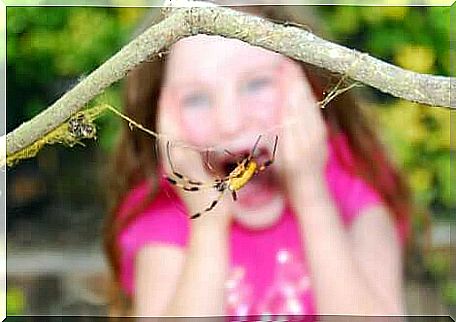Arachnophobia: Fear Of Spiders

An example of an animal phobia is arachnophobia, which is also one of the most common. Phobias are irrational fears of something in particular; the phobic or feared object can be very diverse in nature and one of the most popular is that of animals.
This answer helped us, at one point, to survive as a species: being afraid of being wild or strangers would release enough adrenaline that we could escape. On the other hand, when the fear becomes extreme and we develop a phobia, our whole life can become conditioned.
About 3 in 10 people have an extreme fear of arachnids. This phobia does not only include spiders, but also other arachnids, such as scorpions, mites or ticks.
So even though the majority of people experience this phobia in the presence of large, hardy spiders, the fear may spread or focus on smaller spiders or other types of arachnids. Here we go deeper into the subject.

Phobia
Animal phobias are considered to be specific or simple phobias. They usually develop during childhood or adolescence.
These phobias consist of an irrational fear, either because of the nature of the latter or the level of fear, which causes the person to avoid this object at all costs. As for the manifestation of symptoms, they are very varied.
Some people experience them only when they are in front of the animal, and others can present them at any time. In fact, it is not necessary for the phobic stimulus to be present : the mental image or associated stimuli can already cause fear to appear.
The main symptoms of arachnophobia are those of the rest of the phobias. We therefore find the following symptoms:
- Increased heart rate.
- Sweats.
- Nausea.
- Vertigo.
- Lack of air or hyperventilation.
- Tremors.
- Abdominal pain.
- General malaise.
- Gastrointestinal alterations.
Also, behaviorally, people who suffer from arachnophobia try to avoid these animals at all costs and do everything to stay away from areas inhabited by spiders and places where there are signs of their presence. Many also try to prevent their occurrence and eliminate them.
What are the causes of arachnophobia?
Generally, animal phobias are due to traumatic experiences with the animal in question or to learning. It is possible that someone at home is afraid of spiders and, implicitly or explicitly, has transmitted this fear to a child.
Fear can also be transmitted genetically. However, all of this is not strictly necessary to develop a phobia.
The component of disgust that characterizes arachnophobia has led experts to believe that this may be a more progressive fear. A kind of advantage that has helped us survive in the face of lethal stings or other little-known dangers.
A study carried out by researchers at the Max Planck Institute in Leipzig (Germany) ensures that arachnophobia has an innate and evolutionary origin. In this study, the anxiety of babies in front of photos of spiders and snakes was measured: the pupil dilation of the young was analyzed.
This research found that babies displayed signs of anxiety (dilated pupils) when looking at pictures of these animals. This was not the case with pictures of flowers and fish.

Can we treat her?
All phobias can be treated successfully. With the help of a professional in psychology, one can learn relaxation techniques which, in addition to relieving symptoms, will serve as support for systematic desensitization.
This technique consists of a gradual exposure to the phobic object. Thus, at first, we will carry out relaxation exercises in front of photos of spiders, for example. The last goal will be to be able to remain calm in front of a living animal.
It is also advisable to work on your beliefs vis-à-vis arachnids, because ignorance reinforces fear. It is therefore very beneficial to benefit from precise information about the object of the phobia. It would then be good to collect information on the risks of an injection or the number of people who die due to poisoning, for example.
Even so, arachnophobia, due to its disgust component, is one of the most difficult animal phobias to eliminate. This emotion is more instinctive and far removed from all reasoning: getting rid of it is therefore more complicated. Psychological work can, however, decrease symptoms and negative thoughts.










